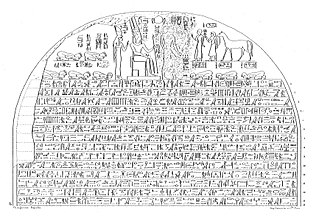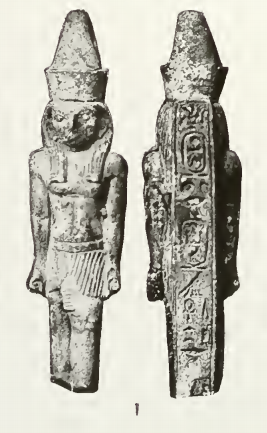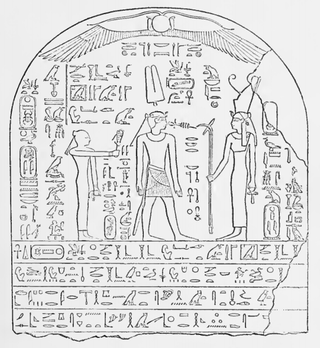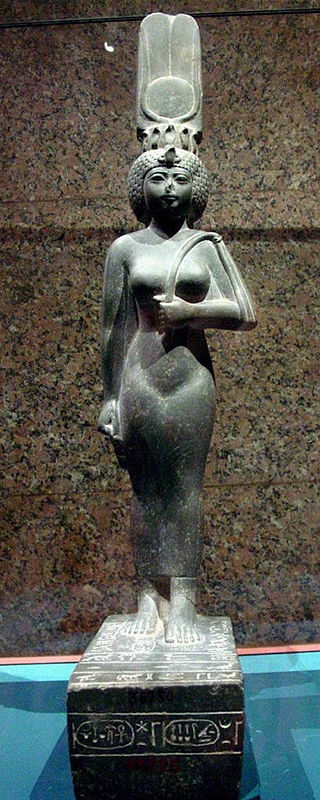
Piye was an ancient Kushite king and founder of the Twenty-fifth Dynasty of Egypt, who ruled Egypt from 744–714 BC. He ruled from the city of Napata, located deep in Nubia, modern-day Sudan.

Thutmose IV was the 8th Pharaoh of the 18th Dynasty of Egypt, who ruled in approximately the 14th century BC. His prenomen or royal name, Menkheperure, means "Established in forms is Re." He was the son of Amenhotep II and Tiaa. Thutmose IV was the grandfather of Akhenaten.

Menkheperre Necho I was a ruler of the ancient Egyptian city of Sais. He was the first securely attested local Saite king of the 26th Dynasty of Egypt who reigned for 8 years (672–664 BCE) according to Manetho's Aegyptiaca. Egypt was reunified by his son Psamtik I.

Userkare Khendjer was a minor king of the early Thirteenth Dynasty of Egypt during the Middle Kingdom. Khendjer possibly reigned for four to five years, archaeological attestations show that he was on the throne for at least three or four years three months and five days. Khendjer had a small pyramid built for himself in Saqqara and it is therefore likely that his capital was in Memphis.

Menkheperre, son of Pinedjem I by wife Duathathor-Henuttawy, was the High Priest of Amun at Thebes in ancient Egypt from 1045 BC to 992 BC and de facto ruler of the south of the country.

Hedjkheperre Setepenre Takelot II Si-Ese was a pharaoh of the Twenty-third Dynasty of Ancient Egypt in Middle and Upper Egypt. He has been identified as the High Priest of Amun Takelot F, son of the High Priest of Amun Nimlot C at Thebes, and thus, the son of Nimlot C and grandson of king Osorkon II, according to the latest academic research. Based on two lunar dates belonging to Takelot II, this Upper Egyptian pharaoh is today believed to have ascended to the throne of a divided Egypt in either 845 BC or 834 BC. Most Egyptologists today, including Aidan Dodson, Gerard Broekman, Jürgen von Beckerath, M.A. Leahy, and Karl Jansen-Winkeln, also accept David Aston's 1989 hypothesis that Shoshenq III was Osorkon II's actual successor at Tanis, rather than Takelot II. As Aidan Dodson and Dyan Hilton write in their comprehensive book on the royal families of Ancient Egypt:
Takelot II is likely to have been identical with the High Priest Takelot F, who is stated in [the] Karnak inscriptions to have been a son of Nimlot C, and whose likely period of office falls neatly just before Takelot II's appearance.

Usermaatre Setepenamun Osorkon II was the fifth king of the Twenty-second Dynasty of Ancient Egypt and the son of King Takelot I and Queen Kapes. He ruled Egypt from approximately 872 BC to 837 BC from Tanis, the capital of that dynasty.

Sekhemkheperre Osorkon I was an ancient Egyptian pharaoh of the 22nd Dynasty. Osorkon's territory included much of the Levant.

Jürgen von Beckerath was a German Egyptologist. He was a prolific writer who published countless articles in journals such as Orientalia, Göttinger Miszellen (GM), Journal of the American Research Center in Egypt (JARCE), Archiv für Orientforschung (AfO), and Studien zur Altägyptischen Kultur (SAK) among others. Together with Kenneth Kitchen, he is viewed as one of the foremost scholars on the New Kingdom and the Third Intermediate Period of Egypt.

Hedjkheperre Setepenre Smendes was the founder of the Twenty-first Dynasty of Egypt and succeeded to the throne after burying Ramesses XI in Lower Egypt – territory which he controlled. His Egyptian nomen or birth name was actually Nesbanebdjed meaning "He of the Ram, Lord of Mendes", but it was translated into Greek as Smendes by later classical writers such as Josephus and Sextus Africanus. According to the Story of Wenamun from c. 1000 BC, Smendes was a governor of Lower Egypt during the Era of the Renaissance under the reign of Ramesses XI, however, Egyptologists have questioned the historical accuracy of this story.

Menkheperre Ini was an Egyptian king reigning at Thebes during the 8th century BC following the last king of the 23rd Dynasty, Rudamun.

Sekhemre Wahkhau Rahotep was an Egyptian pharaoh who reigned during the Second Intermediate Period, when Egypt was ruled by multiple kings. The Egyptologists Kim Ryholt and Darrell Baker believe that Rahotep was the first king of the 17th Dynasty.

Ankhnesneferibre was an ancient Egyptian princess and priestess during the 26th Dynasty, daughter of pharaoh Psamtik II and his queen Takhuit. She held the positions of Divine Adoratrice of Amun and later God's Wife of Amun between 595 and 525 BC, during the reigns of Psamtik II, Apries, Amasis II and Psamtik III, until the Achaemenid conquest of Egypt.

Sekhemre Seusertawy Sobekhotep VIII was an ancient Egyptian ruler during the Second Intermediate Period whose exact chronological placement remains uncertain. He may have ruled over the Theban region in Upper Egypt. Scholars debate whether he belonged to the 13th, 16th, or 17th Dynasty. If Sobekhotep VIII was a king of the 16th Dynasty, it is thought that he is listed in the Turin Canon (11:2), which credits him with a 16-year reign.

Khahotepre Sobekhotep VI was an Egyptian king of the late 13th Dynasty during the Second Intermediate Period.
Senusret IV Seneferibre was an ancient Egyptian Theban king during the late Second Intermediate Period that is attested only through finds from Upper Egypt. The chronological position of Senusret IV is unclear and even the dynasty to which he belongs is debated.
Merkawre Sobekhotep was an Ancient Egyptian king during the Second Intermediate Period.

Seth Meribre was an Ancient Egyptian petty king during the early 13th Dynasty during the late Middle Kingdom.

Nerikare was an Egyptian pharaoh of the 13th Dynasty during the Second Intermediate Period.

Menkhaure Snaaib was an Egyptian pharaoh during the Second Intermediate Period between the Middle Kingdom and New Kingdom at the end of the Middle Bronze Age.


















